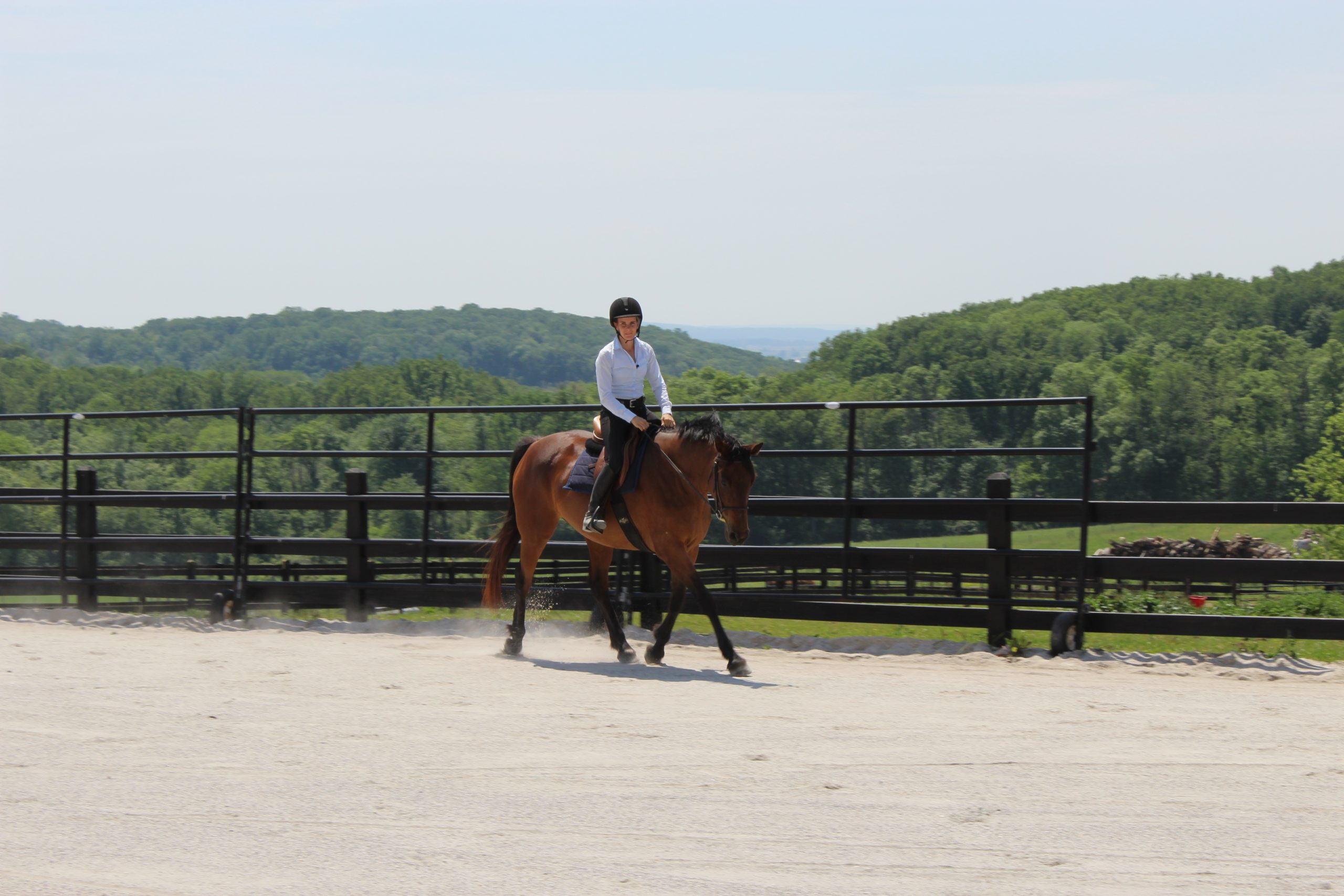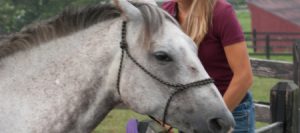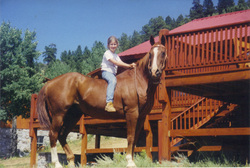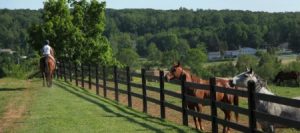One of my favorite quotes for riding and horsemanship comes from someone who was in a field far removed from horses – mathematics.
George Poyla was a Hungarian mathematician, but a simple statement he made in regard to solving mathematics equations applies directly to us equestrians.
[Tweet “If you can’t solve a problem, then there is an easier problem you can solve: find it. – George Poyla”]
It may seem common sense to break down a problem, but so often we get stuck thinking we’ve tried it all or the situation is hopeless. I believe that there is always a way to make a problem just a bit easier or to change it entirely so we can find success and begin moving forward again.
In today’s video, I share ideas to break down two common problems – getting a spooky horse better on the trail, and comfortably riding the sitting trot. I also show a few clips about how I worked with a horse who had a fear of traffic – again, by finding easier problems…
Hit play to watch the video, then leave a comment below!














29 Responses
Your advice is spot on – someone said “always set your horse up for success”. I’ve found problem solving and/or training goes so much quicker and easier when you break it down into small steps. It builds up confidence in the horse and he learns to trust that you’re not going to put him in a situation that he can’t handle.
I think your advice is great for ground training too. I had a trainer work with my Fjord, who was afraid of the hose and the trainers got her to accept the hose, but not without a lot of tugging on the horse and manhandling her. With patience and breaking it down more, I think the manhandling could have been eliminated. I don’t use that trainer any more. Also, a question: Couldn’t you use a word or phrase, like “good girl” instead of a clicker? That way I will always have it with me and I don’t have to phase a clicker out. It seems to work pretty well with my two-year olds.
I am fortunate to take lessons from Callie and to participate in a small “behavior class”. We have talked about and even practiced a little clicker training. I believe that she would say that you can use many things to “mark” the desired behavior, as long as the horse has previously associated that thing with a tangible reward (often a food treat). So yes, you could use “good girl”, an enthusiastic “YES!”, a tongue cluck (sort of like a clicker sound), or the clicker itself. The important thing would be consistency.
Great tips as always Callie, thank you!
Thanks Callie! Once again you have hit a on key issue and given wonderful advice to help us move forward on a positive path. I have a young horse and have a basic level of riding, confidence and training skill and find I often use ground work to make use both feel more comfortable about a challenge …such as a spooky corner of my riding area. I have done this sometimes with a feeling of not being ‘good enough’ to deal with the issue in the saddle but you have given my confidence a little boost by ‘endorsing’ my more cautious strategy
Thanks for this great video! I actually did this (breaking things down) without realizing I was doing it. My new BLM mustang is afraid of many things, one of which is the large black trash bin when it’s being moved. When it’s stationary, he will stick his head in it. If it moves, he runs away. So, I decided to bring one of the trash bins into his paddock area and just start pulling it, far away from him and around the other two horses who aren’t afraid of it. Little by little, he has gotten more comfortable with the moving trash bin. We do a lot of me stopping it, rocking it & letting him play with it, he’ll even follow it now. He’s figured out that the lid makes a good scratching post. And, we are almost comfortable with the bin going closely around the hindquarters. We’ve had two sessions and will do a few more. By breaking down the movement of the bin (big problem) into little steps (easier problems), he will soon not even flinch when it’s being pulled next to him. Yay!
I’ve used this method for my draft cross. She was spooky outside of the arena. She now goes out on trail alone with very little trouble or spookiness
Great video, Callie, I really appreciated it. Breaking a problem down into smaller steps is something many of us don’t think to do, because we’re so focussed on the goal instead of the process. Also, I’ve found that it’s important for me to pick my training conditions carefully. For example, working with a spooky or difficult horse on hard ground, or in front of lots of other people, or during a group trail ride, is probably not the best choice.
Great tip for horses and life.
Wonderful lesson! Years ago, when I was having major issues with an Appaloosa stallion I’d rescued, an old timer gave me some sage advice…told me to “take baby steps”…it’s so easy to fall into the trap of wanting it all at once, but all this takes time and patience. Keep up the good work…being here all by myself, these weekly lessons are great and much appreciated!
I am working to get Gracie to walk, gait, and canter on cue and to transition from one gait to the other as I ask. She is Paso Fino with a fair amount of brio and she just wants to build speed especially with other horses. I have been working ground work with her she is very calm and obedient on the ground, but a very different horse in the saddle. I have been working consistently for about 2 months on getting her to do all these gaits on a loose rein, but she is not making much progress. I’m not sure how to break this down. Any suggestions would be appreciated.
She flexes laterally and knows the one rein stop.
My horse is spooky when being ridden in the arena. She’s alot calmer outside.
I could start just walking her around the arena once and then heading outside.
It becomes a huge problem in winter.
Once again, a great video! Thank you for all your good advice!
Hi Callie
Great reminder to break/ slice problems down. Been trying to do this with my Annie.
On our way home from trail riding she speeds up, and i try to slow her down unsuccessfully. Needless to say- very frustrating for both of us.
Stopped long trailrides. Worked on going for two min, than coming back- repeatedly; works ok for a while…than she gets frustrated – and so do I.
Thought roundpen would be good way to help. Stuck again. Miss Lead Mare KNOWS exactly what i ask her, but after a wile she just ” flips me the finger”. In roundpenn she starts to canter.
Cant figure out how to help her ( help myself).
Love your approach to teaching people how to be with their hoses- thanks!!!!!
Tina
thank you again, excellent advice!
Thanks Callie! Another great video with wonderful advice for riding and life.
I notice that breaking things down into smaller steps requires more patience, which is always good for me to practice. I have also found that slow steady progress leads to longer lasting outcomes!
Thank you! Very valuable boost. Something I have intuitively known but haven’t allowed myself to work it out. On to slicing!
Excellent advice, as usual!
I have been working on that that exact thing, getting my spooky gelding used to trail riding.
First I led him along with some friends on their horses whom he knows here from the farm.
Then gradually riding him on longer distances, farther from the farm. It has made a huge difference!
I love the sitting trot advice, that is something I have had less success in, I will try those ideas. Thanks again!
I see this concept as being a great confidence builder for both horse and rider. Makes a lot of sense!
The horse I lease and ride was rescued 2 years ago. He is mostly a quite, obedient horse, but has a few issues that set him off. At first I had no idea what would set him off or when it would happen. Originally Utah would not stand in the wash stall without rearing, let alone putting him in the cross ties. Slowly I began to work with him. At first when we entered and left the barn we walked past the wash stall. After a while, we began walking in the wash stall and right out again. After we could so that, we began walking in the wash stall and standing for a few seconds. Utah received a carrot treat if he could stand for five seconds. I began to increase the stand time. Gradually Utah was able to tolerate being in the wash stall without carrot treats. I still can not cross tie him, but he will stand in the wash stall long enough for me to wash/rinse him and loves to have his belly scrubbed with the scrub brush. Occasionally he gets intolerant, and will begin to walk out of the wash stall, but the rearing has stopped and he is usually well behaved in the wash stall now. I am only at the barn three times a week so this process took months. By spring of the next year, Utah was able to stand calmly, untied, in the wash stall for me.
Excellent video that is short, yet simple and concise. In working with horses and those learning to ride, I too, “break it down” into smaller chunks or steps. I learned this concept many years ago from an older man who was in the U. S. Calvary. In education, this is known as scaffolding. Without this process, attempting a skill or technique generally becomes overwhelming and frustrating. People may become angry and oftentimes “blame” the horse when in reality it’s a miscommunication. The rider or trainer may have intended one thing to happen, but instead a different response occurs. I find this to be a very common occurrence.
Thank you for sharing and promoting this concept as I’ve yet to see or hear this anywhere else. By simplifying the process in breaking something down into segments or steps, you are point on in having higher potential to celebrate success. Whether human or animal, you can avoid what we call “drill and kill”… over doing or over practicing something because the horse and/or student cannot seem to “get it.” Awesome!
hi callie your amazing i love your vids
One problem that I have with my riding is the canter transition. My instuctor wants me to canter from a walk,which is fine, but, sometimes when i try to do that, depending on the horse,he/she usually ends up trotting a couple steps before hand. Or maybe not even cantering at all. Any tips? It would be really helpful. thanks
Hi Terrah, to canter from walk the horse needs to lift their front end and push from behind. If they aren’t in the right balance or simply aren’t strong enough to push off hose few trot steps can happen. The key is feeling the correct balance for your horse to get the best transitions. Focus on feeling the difference between the transitions. Also be careful to stay upright in your body and. To lean forward for the canter
Hi Callie, I had a very bad fall about 3 months ago and my confidence is a problem, but I am going to brake this “problem” down in smaller steps in order to get my confidence back. More ground work before I saddle up again … thanks for you advise !!!
Hi Callie, I’m 61 and got my first horse 4 & 1/2 yrs ago. I didn’t really know much about riding, horses and training. Although in my youth I was fearless and would jump on and ride. I bought a 9 yr mustang that was barely halter broke. With the help of the young gal that runs the barn where I board my horse, I’ve been training my horse at the same time as learning about riding myself. It’s been extremely rewarding yet really difficult at times too. At my age all the fearlessness is gone. My main problem currently is my lack of confidence and knowing that my horse surely knows this. We have a very good bond. She’s a very spooky horse. I’m mostly alone when I go to the barn now. The manager has another job that takes her away and I often feel helpless. All the other gals at the barn have horses that ‘came trained’ and are always trailering off for rides while I’m left behind. They think it’s as easy as just loading up my horse and going with them. The few times my horse has been in a trailer she was afraid and nervous and upset and just yesterday as I walked her near a trailer she got very upset. Breaking things down into small successes is exactly what I need to do. Both for my horse and myself. I will make myself a list, what I hope to accomplish, then go backwards from that goal, tiny step by tiny step. And start at the beginning. It’s just hard doing these things often alone but for complicated reasons, I’m stuck in this situation. It’s easy to feel overwhelmed and discouraged but I need to watch more of your videos and proceed at my own rate and take everything apart to build up both my horse and my confidences. Thank you, Linda
Hi Linda, thank you for your comment! I can hear your frustration but take heart that you are certainly not the only one in this kind of situation. You certainly have chosen a more difficult road with your young mustang, but I am sure you are learning an incredible amount along the way. You’re on the right track by breaking down your challenges into small, manageable steps – keep at it!
Linda,
I had a spooky horse, too, and I’m alone also. Even after 15 years I wouldn’t tie her to ANYTHING. It’s taken years and lots of baby steps to find a solution. I tried exposure – desensitizing – but it didn’t “stick”. I tried calming supplements of all types. At the same time I had a job situation that turned me into a nervous wreck. We two were a dangerous pair with a negative feedback loop, me waiting for her to jump and run, she knowing that bogeyman would knock me to the ground.
I retired a year ago and got serious about solving our problem. Not bringing all that work stress to the barn helped but not enough. First research suggested magnesium, which I also take daily, so I started adding MgO to her feed (2 Tbl). That made a HUGE difference but not enough to fix our feedback loop. Not as fearful but still hair-trigger jumpy. Then I found this website http://www.calmhealthyhorses.com/which has a product and a lot of information about forage. Two things that fit my situation, and maybe yours, was too much grass/simple carbs and not enough salt. Since adding hay (1/4 bale) to my girl’s summer diet (she gets 6 – 8 hours grass daily), changing from a molasses grain blend to a pelleted feed (1 1/2 cups of Tribute Kalm and EZ), and supplementing what seems like an excessive amount of salt (initially 1/3 c. ~ 10 mg/100 Kg now reduced to 1/6 c. ). She now pees huge lakes in her stall and no longer eats to soothe herself. She isn’t as sensitive to my aids, but she is rock solid, pays attention to me, and we have had multiple uneventful rides, albeit slow, as we are getting used to our new pattern.
I don’t know if diet is part of your mustang’s problem but your description matches my mare so it seems possible she has diet-induced ADHD. Her ancestors survived in some of the harshest conditions the American Southwest offers. That environment is rich in minerals but the forage is poor with few simple carbohydrates. The modern domestic equine environment is sugar rich and nutrient-poor whether grass, grain, or hay and in a group situation there can be a lot of peer pressure, especially if you’re the rookie. I encourage you to do some research and experiment. You know more than you think you do.
Not only that, but hats off to you for taking on the BLM challenge!
Regards,
Elisa & Franc’s
I am working on the opposite. My horse is good on the trail but tries to run away with me in an arena. I can ride her into the arena if she has a buddy to follow. But then she always wants to follow the other horse and gets very upset when I try to steer her in another direction.